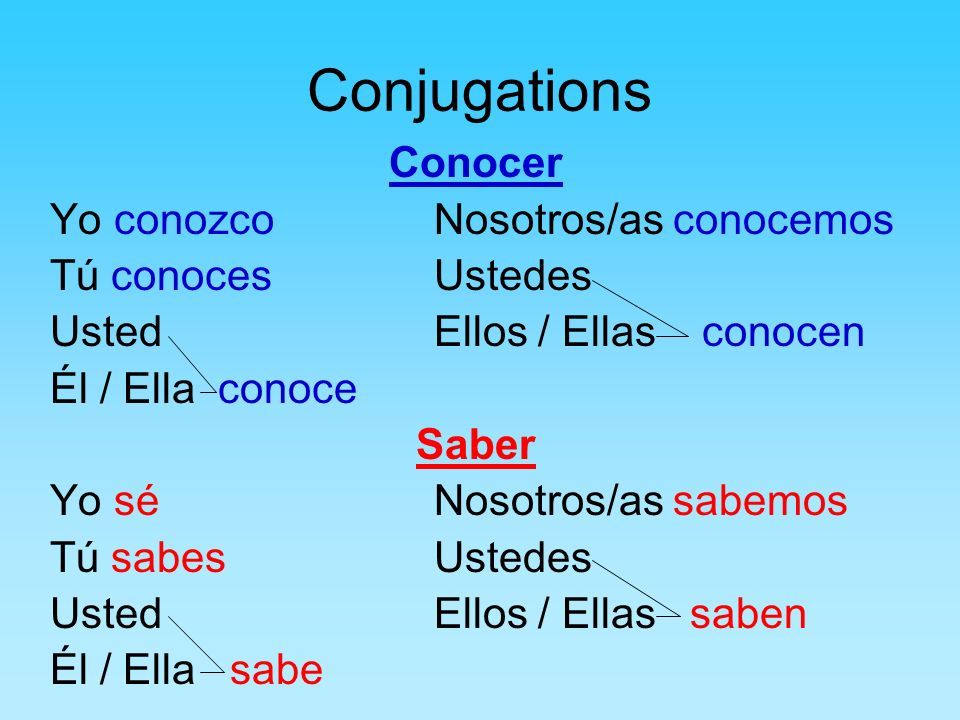Saber Conjugation: Saber, a common Spanish verb generally meaning “to know” in the sense of knowing, is highly intermittent. Both the stem and the endings may take unexpected forms.
Saber Conjugation shouldn’t be confused with conocer, which also means “to understand,” but in the sense of becoming familiar with a person. Conocer also is conjugated irregularly Irregular forms are displayed below in boldface. Pronouns are shown for convenience and clarity; they frequently are omitted in everyday speech and writing.

Saber Conjugation: Utilizing The Verb”to understand”
In a Latin-based language like Spanish, many verbs follow a regular pattern based on their endings (i.e. -ar, -er, and -ir verbs).
But, also, many irregular verbs don’t always adhere to a regular conjugation pattern. These kinds of verbs are divided into the following:
Stem-changing verbs (which change depending on how they are utilized in a sentence) Spelling-changing verbs (that have different consonants that help with pronunciation) Then you will find reflexive verbs (which reveal what/whom the topic of the sentence is by”reflecting” the action back on the topic). These can be both irregular and regular.
We are going to be focusing on “saber” in this article. However, simply to give you a heads up, two verbs in Spanish mean “to know”. Another one is “conocer”. Generally, “saber” refers to broader understanding (how to do things), whereas “conocer” generally refers to knowing more specific things, like individuals and places.
Much like many other irregular verbs, “saber” is irregular from the “yo” form of the present tense. It’s also important to note using the accent marks. Suggested – What Is Angular Velocity Equation? Easy Definition, Formula, Examples
Current Indicative Of Saber Conjugation
Sé (I understand), tú sabes (you know), usted/él/ella sabe (you know, he/she understands), nosotros/as sabemos (we know), vosotros/as sabéis (you understand), ustedes/ellos/ellas saben (you/they know).
Yo supe (I knew), tú supiste (you understood), usted/él/ella supo (you, he understood), nosotros/as supimos (we knew), vosotros/as supisteis (you understood), ustedes/ellos/ellas supieron (they knew).
Saber Conjugation Vs Conocer Conjugation
In the present tense, both saber and conocer are regular in all conjugations except for the first individual. Here are the conjugations of saber and conocer in the present tense below. Read More – What Is Social Stratification
How To Use The Verbs Saber And Conocer
Hola, ¡buenos días!? Hoy vamos a aprender sobre los verbos saber y conocer… y usted va a saber mucho más.
The verb saber is one of the 2 ways to state ‘to understand in Spanish. It’s used to express understanding of information, particular pieces of advice, or the way to do something, a capability. What about who, what, where, when, why, and how? These would be the interrogatives, but they are also utilized to extract information: when is your party, who’s the man, at which the restaurant is. With these expressions, quién, qué, dónde, cuándo, por qué, and cómo, we will utilize saber.
Ahora vas a conocer a Mario. Él conoce a Antonio, conoce a Sara, y conoce a Lucas, pero no conoce a Adriana. Mario también conoce muy bien las novelas de Ernest Hemingway, porque es profesor de literatura norteamericana.
The verb conocer is the other way to say ‘to know’ in Spanish. It is used to state being familiar or familiar with people, places, or things. Employing conocer, we might express closeness with a city, knowledge of a book or movie, and someone knows an acquaintance. If a person understands a certain individual, we have to use the personal ‘a’ before the title of the individual. That’s the reason why we say Antonio conoce a Sara rather than just Antonio conoce Sara. Therefore, what would we use from the following examples? Also Read – Standard Form to Vertex Form? With Examples